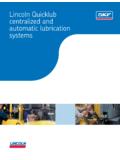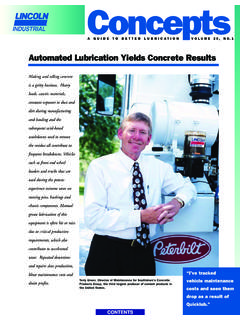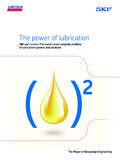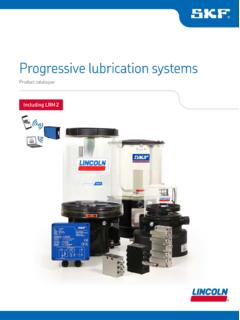Transcription of Installation and Troubleshooting Manual - Ormac
1 Installation and Troubleshooting Manual Lincoln Automatic Lubrication Systems One Lincoln Way, St. Louis, MO 63120 (314) 679-4200, Fax (314) 679-4359 2 Table of Contents MACHINE COMPONENT LUBRICANT METERING SUPPLY AND FEED COMBINING OUTPUT OF MULTIPLE METERING DEVICES TO ONE CENTRO-MATIC Side Adjustment Injectors:..4 SL-32, SL-33, SL-42 & Top Adjusting Injector types:..4 SL-11 Modular Lube UV Divider Quicklub Divider SUPPLY LINE SUPPLY LINE SUPPLY LINE GUIDELINES FOR LOW PRESSURE OIL SYSTEMS.
2 7 GUIDELINES FOR HIGH PRESSURE GREASE SYSTEMS:..8 SYSTEM START-UP AND TROUBLE INITIAL START-UP CENTRO-MATIC Fine Tune INITIAL START-UP MODULAR LUBE AND QUICKLUB PROGRESSIVE TROUBLE SHOOTING CENTRO-MATIC TROUBLE SHOOTING QUICKLUB PROGRESSIVE TROUBLE SHOOTING - MODULAR LUBE DIVIDER PERFORMANCE Reset Type Performance Pin Type Atmospheric LOCATING BLOCKAGE IN A MODULAR LUBE Master Divider Valve Equipped With Performance Indicators:..14 Master Divider Valve Without Performance Indicators.
3 15 OTHER LUBRICANT CENTRO-MATIC SYSTEM MODULAR LUBE SYSTEM QUICKLUB SYSTEM 3 Machine Survey It is recommended that in the process of developing the lube system, a survey of the machine is made, and a schedule of lubrication points is created. This schedule should include the location of the bearing or lube point, the bearing size, 8-Hour lube requirement, and the measuring devices to use at each point. It may also be desirable to add an area for any remarks for each lube point and note any special considerations, which must be made for that particular point.
4 This schedule will help in further development of the automatic lubrication system. During the machine survey, attention should be given to potential mounting locations for the specific automatic lubrication system components. It is advisable to discuss these locations with a representative of the customer who is knowledgeable about the operation and function of the piece of equipment being surveyed. A location the system designer feels is a logical place to mount a component may turn out to be inappropriate because of certain aspects of the machine s operation or maintenance.
5 Component Location Components of an automatic lubrication system should be mounted in areas that will allow the system to operate efficiently, as well as allowing access for routine maintenance, inspection, Troubleshooting and repair. Pumps Factors to consider when locating the pump are: Accessibility to the power source for the pump. Pumps can be manually activated, or powered by compressed air, hydraulic fluid, or electrical current. Protected from possible damage that could be caused by operation of the equipment, or extraneous factors resulting from the function of the machine.
6 Refilling or replacement of the lubricant reservoir. Testing and Troubleshooting system operation. Routine maintenance Repair Lubricant metering devices Factors to consider when locating lubricant measuring devices are: Grouped in such a way that the largest number of lubrication points can be serviced from a single location with the minimum length of feed line possible. Located to allow maintenance personnel safe, easy observation of cycle indication devices. Located in an area that affords adequate protection from damage that could be caused as a result of normal operation of the machinery, or extraneous factors resulting from the function of the machine.
7 Located such that maintenance personnel can safely and easily perform maintenance and repair. Supply and Feed Lines Factors to consider when routing lubricant supply and feed lines are: Keep lines as short as possible. Route lines in such a way that they can be easily anchored or secured to the equipment. Ensure lines are protected from damage that could occur as a result of normal operation of the machine, or extraneous factors resulting from the function of the machine. 4 When lubricant lines are routed in an area where they could be damaged, adequate guarding must be installed.
8 Common materials such as angle iron, channel iron, and heavy wall pipe can all be used to fabricate guards. Be sure to allow adequate slack in lines to facilitate for movement of parts of the machine. Combining Output of Multiple Metering Devices to One Bearing Centro-Matic Injectors Many times it may be more economical to combine the output of two or more injectors to feed one bearing rather than using a larger injector. The examples below indicate how this procedure is done with each of the Lincoln Centro-Matic injectors.
9 Side Adjustment Injectors: SL-32, SL-33, SL-42 & SL-43 A 1/8 tube tee, such as 82665 can be used to combine the lubricant output from two injectors into a single feed line to service one bearing whose lubricant requirement exceeds the capacity of a single injector. This arrangement is rarely used as a larger output injector may be used. Top Adjusting Injector types: SL-1, SL-41, SL-44, and SL-V These injectors are designed so that the lubricant output of two or more injectors can be combined without the use of tees.
10 The injector body has two outlet ports, one above the other. Connector tube part number 81646 is used to couple the injectors together. Lubricant from injector #1 is directed through the connector tube into the discharge chamber of injector #2. Lubricant does not go through the mechanism of injector #2, but simply combines with the lubricant delivery of injector #2 to yield more output from the outlet of injector #2. This does not interfere with the operation of either injector.





